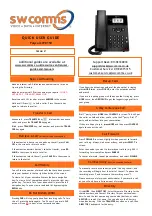
MERak
MMk-656
Compact Emergency Telephone for Lifts
Rev. M1.5 – S2.5
©
MERak. All rights reserved
Instruction and Connection Manual
7 of 20
2.3.
Start-up
1.
Connect the device to the external power supply 10-30 Vdc (
J2
).
2.
Check that the status led is turned on green light and the device plays locution
“
Lift Car
1
”
.
3.
Connect the battery to the corresponding terminals (
J2
).
4.
WARNING
: Never connect the power supply to the terminals intended for batteries B+
and B-.
5.
Connect the phone landline (
J4
).
3.
GENERATION OF ALARMS
The emergency telephone MMk-656 is capable of making automatic calls to different pre-
programmed telephone numbers stored in memory, as different switches are thrown.
The different alarm generators are:
- Car alarm switch:
There are two car alarm generation points (see also section 14.14 WIRING DIAGRAM):
1.
At the
J1
ALC
and
J1.2 ALC
terminals of the telephone module.
2.
Connecting the audio module MMk-698/4, at its
J2.1
and
J2.2
connector.
Following an audible countdown in the car, a call to the first number in the bank of registers
dedicated to storage of alarm telephone numbers (bank of registers 02 to 05) is initiated. If
communication cannot be established, the set will make a programmed number of automatic call
attempts to the numbers stored in the following registers.
If, within ten minutes of the generation of the alarm, the car button is pressed again, the set
will not start again from the first number of the list, but from the number following the last one called.
Once this time has passed, when the button is pressed again, the call attempts will again start from
the first number in the list.
- Maintenance alarm switch (SOS):
This alarm can also be raised at different points:
1.
A switch at the pair of terminals
J1 SOS/EOA
and
J1 SOS/EOA
.
2.
At specific terminals of the audio module (see the instruction manual available on MERak
website www.merakeurope.com).
It makes a call to the number stored in the first register of the equipment (register 01). This
switch is designed to offer the installer the possibility of communication with the centre in the event






































